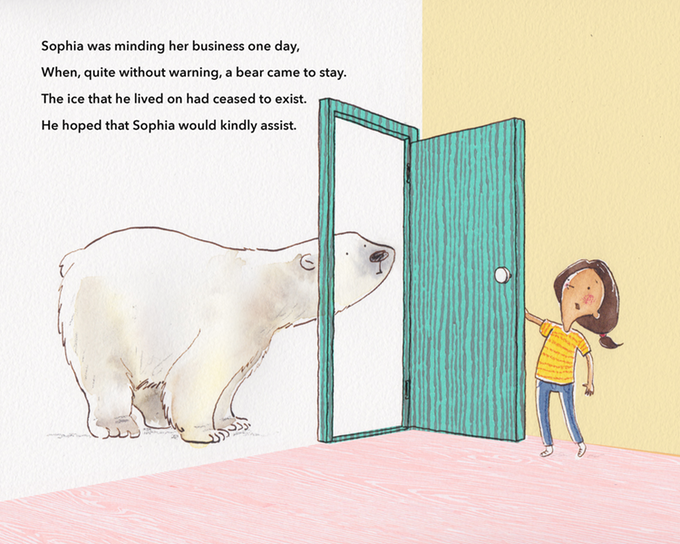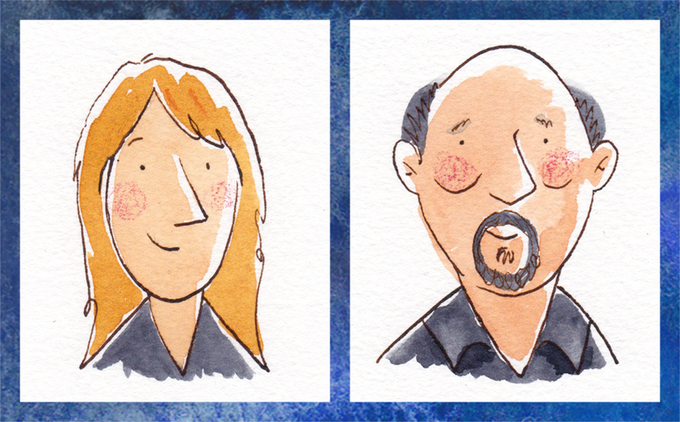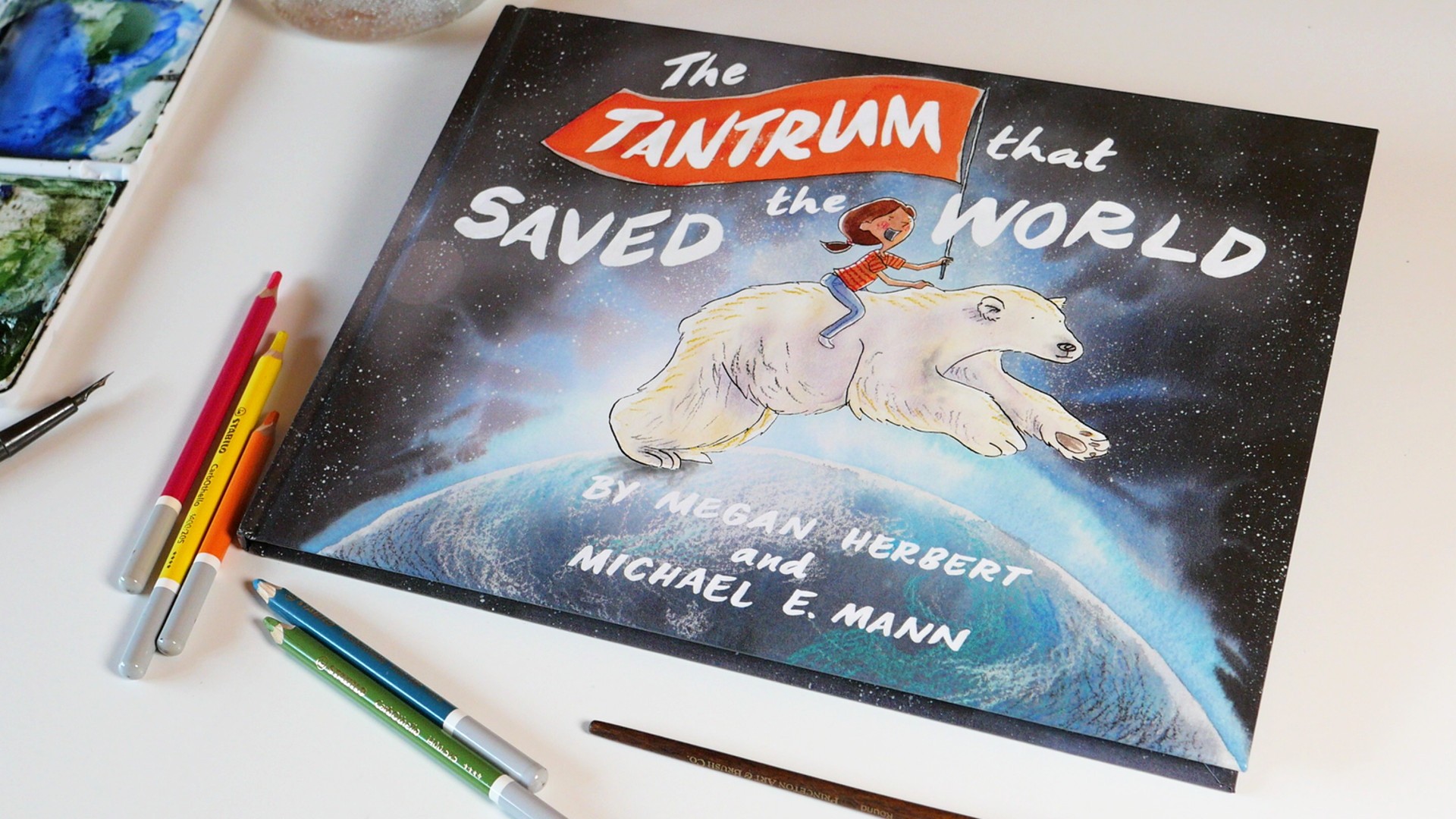Sometimes truly effective change starts when a polar bear knocks at your door and asks for a place to live.
Well, maybe those exact circumstances aren’t too common, but they do kick off a marvelous new kids’ book, The Tantrum That Saved the World, by writer/artist Megan Herbert and climate scientist Michael E. Mann.
The book opens when a young girl named Sophia meets a desperate polar bear whose Arctic home has melted away, leaving him with no place else to go.
“The ice that he lived on had ceased to exist. He hoped that Sophia would kindly assist.”

It turns out the polar bear is not alone. Soon he and Sophia are joined by other climate refugees: farmers whose land has flooded; fishermen whose nets have come up empty; and a flamingo, sea turtle and Bengal tiger that have fled various climate-threatened habitats.
Sophia sets out to help these lost souls, only to be met with resistance and dismissal by her local government officials.
“Someone must help them. Why not you,” Sophia asks.
“We see you’re upset, but we’ve got things to do,” comes the backhanded reply.
Sophia feels momentarily helpless and frustrated at this inaction — common emotions among people who care about environmental issues. That’s something the authors say they needed to tap into.
“This is exactly the feeling that the book addresses, because it was exactly the feeling that we were experiencing ourselves,” says Herbert. “Some days it feels like no one in a position of power to make substantive change — in politics or industry — is really listening or realizing the urgency of the situation we’re in. It can make you want to cry or scream or completely lose hope.”
Mann — who’s faced down the climate-denial machine in order to spread the world about the latest climate-change science — says he feels frustration sometimes himself. “I can tell you that there’s a mix of emotions that I encounter when I speak to audiences about climate change,” he says, “and powerlessness is one of them — powerlessness in the face of what seems like an overwhelming challenge.”

Ultimately, though, the book isn’t about feeling helpless. It’s about overcoming that. Sophia gets motivated, raises her voice, organizes, and throws a tantrum that, well, helps create change and save the world (the title’s a bit of a spoiler).
“We wanted a story that would be empowering,” explains Mann. “I hope that the kids and parents who read this book will indeed feel empowered to make their voices heard.”
Herbert says that’s the key to Tantrum. “When talking to kids about an issue as big and scary as climate change, you need to give them a feeling of empowerment that they can do something about it, otherwise it can lead to a sense of hopelessness and a lack of engagement,” she explains. “We wanted to avoid that at all costs. So by telling kids that yes, this is a huge problem, and it’s not fair that it falls to you, and it’s frustrating and you want to scream, but there are things you can do about it, then it gives them the tools to convert all their negative emotions about it — fear, anger, frustration — into positive ones, like agency, action, positivity and hope.”
Herbert acknowledges that the word “tantrum” has a bad reputation, but says it may be the most important tool we have left. “Tantrums are seen as negative behavior, the last straw for a child with limited means to communicate their frustration to try to be heard,” she says. “Right now, that feels like the position that we’re in. The people who have the will to do something to stop the burning of fossil fuels are being roundly ignored by the people who want to keep burning them. The time for polite conversation and reasonable discussion is past. It’s time for us all to make a lot of noise and demand to be heard. As long as that tantrum is followed up by positive action, then I think it’s completely justifiable.”
She adds, “I don’t think this message is just relevant to kids.” She hopes parents who read this book to their children will also be inspired to speak up and make changes in their households and communities. “I hope they will help their children to contact their elected officials to reach the people who have the power to make bigger legislative changes, and by doing that they will find a way to convert their own frustration into positive action.”
Mann, who just last week won an award for his climate-communication efforts, says working on the book gave him some new communication tools. “Most of my outreach and communication has been aimed at adults,” he says. “I learned a lot from working with Meg about the additional challenges of using appropriate language and explaining things at level that’s accessible to a younger audience. That’s been a very rewarding experience for me.”
In addition to showing Sophia in action, Tantrum also comes with a detailed action guide, giving kids some tools to help change the world themselves, such as saying no to plastic and learning to fix things instead of just replacing them. Beyond those recommendations, Mann says the most important tool for kids is to talk about climate change — “with your parents, your friends, your relatives and your schoolmates. The first step to solving the problem is talking about it. And the more we talk about it, the more difficult it is for politicians to ignore it.”
The Tantrum That Saved the World is available now in e-book form from World Saving Books. A carbon-neutral printed version will ship beginning in March.
Previously in The Revelator:
February’s Best New Eco-books — All 17 of Them



1 thought on “Can Throwing a Tantrum Help Save Us From Climate Change?”
Comments are closed.